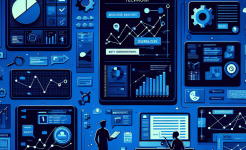Case Study 1: Spotify's Agile Transformation
Spotify, the popular music streaming service, underwent a significant agile transformation to improve its product development process. By adopting an agile iterative approach, Spotify was able to break down its large teams into smaller, autonomous squads. These squads were empowered to make decisions and take ownership of specific features or areas of the product. This led to increased innovation, faster time to market, and improved customer satisfaction. For example, Spotify's squads were able to quickly experiment with new features like personalized playlists and social sharing, based on user feedback. This iterative process allowed them to refine and enhance these features over time, resulting in a more engaging and user-friendly product.
In addition to the squad structure, Spotify also implemented a system of "tribes" and "chapters." Tribes were groups of squads working towards a common goal, while chapters were communities of practice that shared knowledge and expertise across the organization. This hierarchical yet collaborative structure helped to align the efforts of different teams and ensure that best practices were shared throughout the company. The agile iterative development approach at Spotify also emphasized continuous feedback and learning. Teams regularly conducted retrospectives to reflect on their processes and identify areas for improvement. This culture of continuous improvement enabled Spotify to stay ahead of the competition and deliver a product that meets the evolving needs of its users.
Overall, Spotify's agile transformation serves as a prime example of how an organization can benefit from adopting an agile iterative development approach. By empowering teams, fostering collaboration, and embracing continuous improvement, Spotify was able to achieve significant growth and success in a highly competitive market.
Case Study 2: Amazon's Customer-Centric Agile Development
Amazon, the e-commerce giant, is known for its customer-centric approach to business. Agile iterative development plays a crucial role in Amazon's ability to deliver innovative products and services that meet the needs of its customers. Amazon's development teams follow an agile methodology that focuses on rapid experimentation and iteration. They start with a minimum viable product (MVP) and then continuously gather feedback from customers to improve and expand the product.
For instance, Amazon's recommendation engine is a prime example of agile iterative development in action. The initial version of the recommendation engine was a basic algorithm that suggested products based on a customer's past purchases. However, over time, Amazon's teams used customer feedback and data analytics to refine and improve the algorithm. They added features like personalized recommendations based on browsing history, item similarity, and user reviews. This iterative process allowed Amazon to provide a more personalized and relevant shopping experience for its customers, leading to increased sales and customer loyalty.
Amazon also encourages a culture of innovation and risk-taking within its development teams. Teams are given the freedom to experiment with new ideas and technologies, and failure is seen as an opportunity to learn and improve. This culture of innovation, combined with the agile iterative development process, enables Amazon to stay at the forefront of the e-commerce industry and introduce new products and services that disrupt the market.
In conclusion, Amazon's customer-centric agile development approach has been a key factor in its success. By focusing on rapid experimentation, continuous feedback, and innovation, Amazon is able to deliver products and services that exceed customer expectations and drive business growth.
Case Study 3: Netflix's Data-Driven Agile Iteration
Netflix, the leading streaming service, relies on data-driven decision-making in its agile iterative development process. The company has a vast amount of data on user behavior, viewing habits, and preferences. This data is used to inform product development decisions and drive continuous improvement. Netflix's development teams use agile methodologies to quickly test and iterate on new features and content recommendations.
For example, Netflix's user interface (UI) design is constantly evolving based on user data. The company conducts A/B testing on different UI elements to see which ones perform better in terms of user engagement and satisfaction. Based on the results of these tests, Netflix's teams make iterative changes to the UI to improve the user experience. This data-driven approach ensures that the UI is intuitive, easy to use, and tailored to the needs of Netflix's diverse user base.
In addition to UI design, Netflix also uses data to optimize its content recommendations. The company's recommendation algorithm takes into account a wide range of factors, including a user's viewing history, ratings, and genre preferences. By continuously analyzing and updating this algorithm based on user data, Netflix is able to provide more accurate and relevant content recommendations. This iterative process has helped Netflix to increase user engagement and retention, as users are more likely to discover and watch content that they enjoy.
Overall, Netflix's data-driven agile iteration approach has been instrumental in its success as a streaming service. By leveraging data to inform product development decisions and drive continuous improvement, Netflix is able to deliver a personalized and engaging user experience that sets it apart from its competitors.
Case Study 4: Google's Agile Development in Search Engine Optimization
Google, the world's leading search engine, uses agile iterative development to improve its search engine optimization (SEO) algorithms. The company's SEO team is constantly working to enhance the relevance and quality of search results. Agile methodologies allow Google to quickly test and implement changes to its algorithms based on user feedback and data analytics.
Google's SEO team follows an iterative process of hypothesis testing. They start by identifying areas where the search results could be improved, such as relevance, freshness, or user engagement. Then, they develop hypotheses about how to address these issues and implement small-scale experiments to test these hypotheses. Based on the results of these experiments, Google's teams make iterative changes to the algorithms to improve the search results.
For example, Google's Panda algorithm update was a significant change to the search engine's ranking system. The update was designed to penalize low-quality websites and reward high-quality content. Google's SEO team used agile iterative development to test the impact of the Panda algorithm on search results. They conducted extensive user testing and data analysis to ensure that the update was having the desired effect. Over time, Google made iterative improvements to the Panda algorithm based on user feedback and data analytics, resulting in a more accurate and relevant search engine.

In conclusion, Google's agile development approach in SEO has been crucial in maintaining its position as the leading search engine. By using agile methodologies to quickly test and implement changes to its algorithms, Google is able to provide users with high-quality search results that meet their needs.
Case Study 5: Microsoft's Agile Adoption in Software Development
Microsoft, one of the largest software companies in the world, has undergone a significant agile transformation in recent years. The company has adopted agile iterative development practices across its various product teams to improve collaboration, productivity, and product quality. Microsoft's agile transformation has involved a shift from a traditional waterfall development model to an agile approach that emphasizes flexibility, collaboration, and continuous improvement.
One of the key aspects of Microsoft's agile adoption is the use of agile project management tools and techniques. The company uses tools like Azure DevOps to manage its development projects, track progress, and facilitate collaboration between teams. These tools provide real-time visibility into the development process, allowing teams to quickly identify and address issues. Microsoft also encourages a culture of collaboration and communication within its development teams. Teams are organized into cross-functional groups that work together to deliver products. This collaborative approach helps to break down silos between different departments and ensures that everyone is working towards a common goal.
In addition to agile project management tools and collaboration, Microsoft also emphasizes the importance of continuous learning and improvement. The company provides training and resources to its employees to help them develop the skills and knowledge needed to work effectively in an agile environment. Microsoft also encourages its teams to conduct retrospectives and identify areas for improvement. This culture of continuous learning and improvement has helped Microsoft to improve the quality of its products and deliver them more quickly to market.
Overall, Microsoft's agile adoption in software development has been a success. By embracing agile iterative development practices, the company has been able to improve collaboration, productivity, and product quality, and stay competitive in the fast-paced software industry.
Case Study 6: Airbnb's Agile Development for User Experience
Airbnb, the online marketplace for accommodation, uses agile iterative development to enhance the user experience of its platform. The company's development teams focus on creating a seamless and intuitive user experience that makes it easy for travelers to find and book accommodation. Agile methodologies allow Airbnb to quickly test and iterate on new features and design changes based on user feedback.
Airbnb's development teams follow a user-centered design approach. They start by conducting user research to understand the needs and pain points of travelers. Based on this research, they develop prototypes and wireframes of new features and design concepts. These prototypes are then tested with real users to gather feedback and identify areas for improvement. Airbnb's teams use this feedback to make iterative changes to the prototypes and design concepts until they achieve a high level of user satisfaction.
For example, Airbnb's search and filtering features have been continuously improved through agile iterative development. The initial version of the search and filtering functionality was basic, but over time, Airbnb's teams have added more advanced features like location-based search, price filtering, and property type filtering. These features were developed based on user feedback and data analytics, and they have made it easier for travelers to find the perfect accommodation.
In conclusion, Airbnb's agile development approach for user experience has been a key factor in its success. By focusing on user research, prototyping, and iterative improvement, Airbnb is able to create a platform that provides a seamless and enjoyable user experience for travelers.
Case Study 7: Tesla's Agile Manufacturing and Product Development
Tesla, the electric vehicle manufacturer, uses agile iterative development in both its manufacturing and product development processes. The company's agile approach allows it to quickly adapt to changing market conditions and customer needs, and deliver innovative products at a rapid pace. Tesla's manufacturing process is based on the principles of lean manufacturing, which emphasizes waste reduction and continuous improvement. The company uses agile methodologies to manage its supply chain, production schedules, and quality control.
For example, Tesla's Gigafactories are designed to be highly flexible and adaptable. The manufacturing processes in these factories are modular and can be easily reconfigured to produce different types of vehicles or components. This flexibility allows Tesla to quickly respond to changes in demand and production requirements. Tesla also uses agile methodologies in its product development process. The company's development teams work in cross-functional groups to design and develop new vehicles. They use rapid prototyping and testing to quickly iterate on new designs and features. This iterative process allows Tesla to bring new products to market faster and with higher quality.
In addition to manufacturing and product development, Tesla also uses agile methodologies in its software development. The company's vehicles are equipped with advanced software systems that are constantly updated and improved. Tesla's software development teams use agile practices to quickly develop and deploy new features and bug fixes. This iterative approach ensures that Tesla's vehicles are always up-to-date and provide a seamless user experience.
Overall, Tesla's agile approach to manufacturing and product development has been a key factor in its success. By embracing agility, Tesla is able to quickly adapt to changing market conditions, deliver innovative products, and stay ahead of the competition.
Case Study 8: Atlassian's Agile Product Development and Team Collaboration
Atlassian, the software company that develops project management and collaboration tools, uses agile iterative development to build its own products. The company's agile approach is centered around the principles of collaboration, transparency, and continuous improvement
ARTICLE TITLE :8 best practice case studies in agile iterative development ,AUTHOR :ITpmlib

















